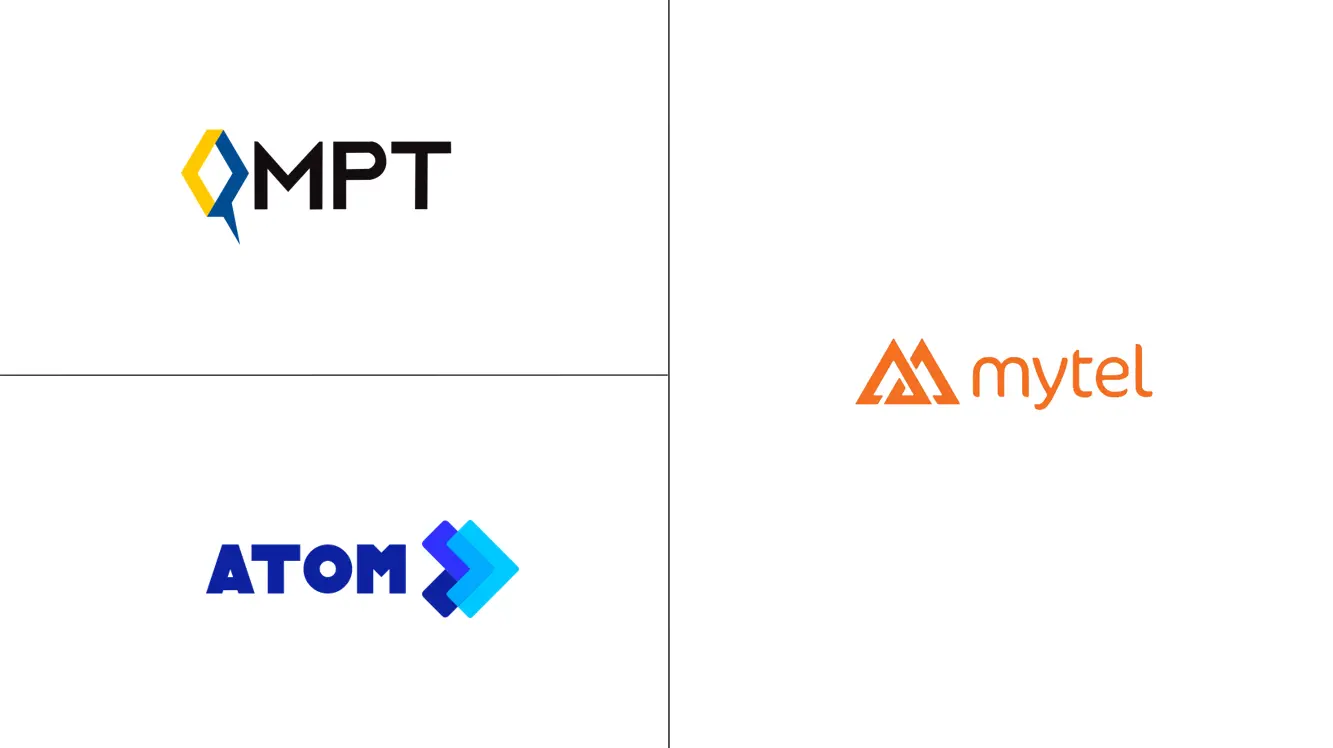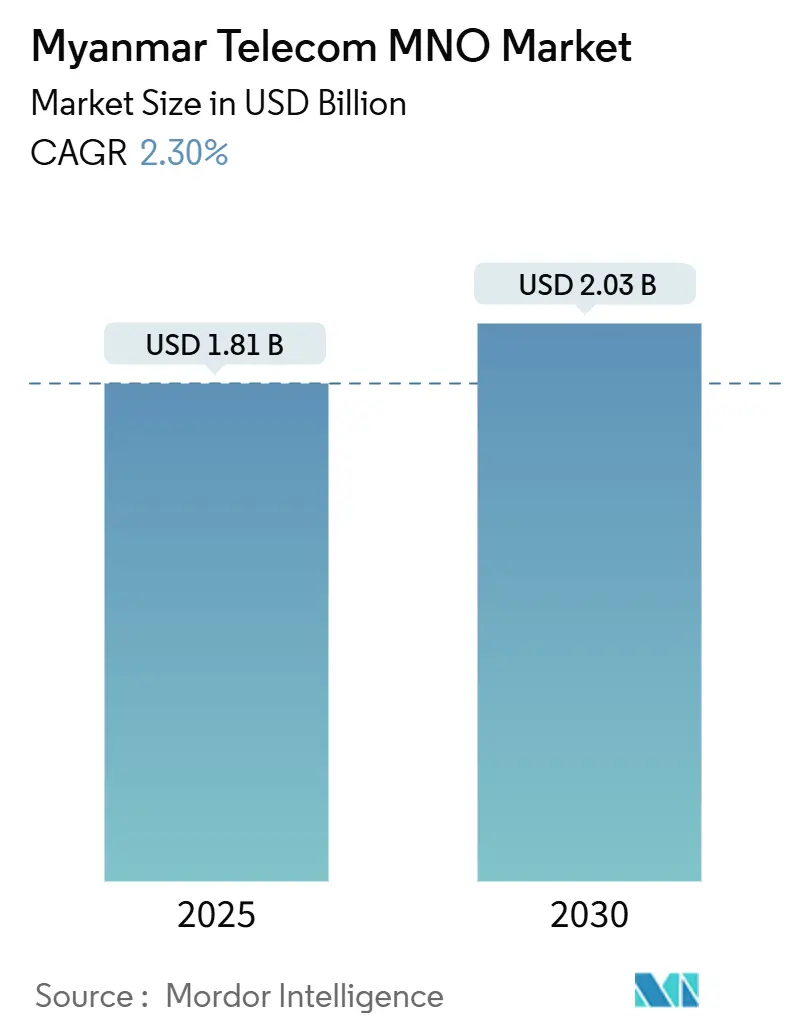
Myanmar Telecom MNO Market Analysis by Mordor Intelligence
The Myanmar Telecom MNO Market size is estimated at USD 1.81 billion in 2025, and is expected to reach USD 2.03 billion by 2030, at a CAGR of 2.30% during the forecast period (2025-2030). In terms of subscriber volume, the market is expected to grow from 62.46 million subscribers in 2025 to 69.35 million subscribers by 2030, at a CAGR of 2.11% during the forecast period (2025-2030).
The Myanmar telecom MNO market continues to grapple with post-coup political risk, foreign‐operator exits, and sanctions that restrain capital formation, yet mobile data usage, fiber roll-outs, and super-app ecosystems still nurture incremental revenue streams. [1]Mobile World Live, “Myanmar telecom operators brace for sanctions fallout,” mobileworldlive.com Data services maintain momentum as smartphone penetration now exceeds 70%, while fiber-to-the-home (FTTH) expansion underpins fixed broadband growth even as tower operating costs surge because of chronic power shortages. Enterprise digitization, mobile money adoption, and satellite back-haul partnerships diversify demand, but foreign-exchange volatility and over 130 documented internet shutdowns in 2024 weigh on margins and suppress network investment.
Key Report Takeaways
- By service type, data and internet services led with 55.01% revenue share of the Myanmar telecom MNO market in 2024, while IoT and M2M services are poised for the fastest 2.39% CAGR through 2030.
- By end user, the consumer segment held 78.94% of the Myanmar telecom MNO market in 2024, whereas enterprise services will register the highest 2.77% CAGR through 2030.
Myanmar Telecom MNO Market Trends and Insights
Drivers Impact Analysis
| Driver | (~) % Impact on CAGR Forecast | Geographic Relevance | Impact Timeline |
|---|---|---|---|
| Shifting usage from voice-centric to data-centric services | +0.8% | National, higher in Yangon and Mandalay | Medium term (2-4 years) |
| Enterprise digitization and cloud adoption | +0.6% | Urban centers, expanding to secondary cities | Long term (≥ 4 years) |
| Government mandate for nationwide FTTH build-out | +0.5% | National, targeting underserved regions | Long term (≥ 4 years) |
| Growth of mobile money and super-apps | +0.4% | National, rural focus | Medium term (2-4 years) |
| Rise of video-led OTT consumption in rural areas | +0.3% | Rural and semi-urban | Medium term (2-4 years) |
| Satellite back-haul partnerships | +0.2% | Remote and conflict areas | Short term (≤ 2 years) |
| Source: Mordor Intelligence | |||
Shifting Usage From Voice-Centric to Data-Centric Services
Mobile internet users reached over 33 million in early 2025, equal to around 61% population penetration, and data revenue now offsets falling voice income. Smartphones comprise 70-80% of handsets in circulation, enabling video streaming and social media that drive new traffic even under intermittent service conditions.[2]CGAP, “Smartphone penetration and financial inclusion in Myanmar,” cgap.orgOperators pursue tiered data bundles to defend average revenue per user (ARPU) and promote zero-rated OTT content, while regulatory throttling of social platforms periodically diverts usage toward domestic applications.
Enterprise Digitization and Cloud Adoption Creating New B2B Demand
Myanmar enterprises accelerate migration to cloud-delivered software to secure operational continuity amid infrastructure risk. Huawei Cloud deployments of SAP Business One have cut costs by 15% for local manufacturers, illustrating tangible benefits that underpin the enterprise segment’s 5.01% CAGR outlook. [3]Huawei Cloud, “SAP Business One case study: Myint Myint Khin,” huaweicloud.com ATOM Myanmar’s collaboration with ZTE on next-generation business-support systems further aligns network capabilities with growing demand for managed IT, cybersecurity, and IoT solutions.
Government Mandate for Nationwide FTTH Backbone Build-Out
The state-led 32,000 km fiber-optic backbone and 1,000 new base-station sites position FTTH as a universal-service vehicle that can reduce the urban-rural divide and unlock fixed-line ARPU upside. MPT already covers half the country with FTTH, giving operators a reliable backhaul alternative to diesel-powered microwave links.
Growth of Mobile Money and Super-Apps Boosting ARPU
Wave Money serves 21 million users—38% of the population—with USD 4.3 billion annual transaction volume, while KBZPay’s 6 million wallets underscore widespread acceptance of digital payments. Operators harness these services through super-apps such as MyID and MytelPay, cross-selling data and value-added offerings that lift blended ARPU.
Restraints Impact Analysis
| Restraint | (~) % Impact on CAGR Forecast | Geographic Relevance | Impact Timeline |
|---|---|---|---|
| Political instability and sanctions crimping capex flows | -1.2% | National, severe for foreign investment | Short term (≤ 2 years) |
| Currency depreciation inflating network opex | -0.8% | National | Short term (≤ 2 years) |
| Chronic power outages increasing tower TCO | -0.6% | Rural and semi-urban | Medium term (2-4 years) |
| Social-media shutdown risks suppressing data traffic | -0.4% | National | Short term (≤ 2 years) |
| Source: Mordor Intelligence | |||
Political Instability and Sanctions Crimping Capex Flows
US sanctions on Mytel in January 2025 compel American suppliers to halt transactions and discourage other foreign investors, replicating earlier exits by Telenor and Axiata. Operators now depend on domestic or regional vendors, which stretches deployment timelines, delays 5G monetization, and dampens the Myanmar telecom MNO market growth outlook.
Currency Depreciation Inflating Network Opex
The kyat has lost more than 160% of its value against the USD since 2021, sharply raising the cost of imported radio gear, fiber, and fuel for generator-backed base stations. Margins tighten because local tariffs are denominated in kyat, while inflation erodes consumer purchasing power and limits upward price revision.
Segment Analysis
By Service Type: Data Services Lead Digital Transformation
Data services contributed 55.01% of 2024 revenue, underlining their central role in the Myanmar telecom MNO market. IoT and M2M’s 2.39% CAGR reflects enterprise appetite for smart factory, agriculture, and smart-city deployments even amid political risk. The data-centric shift supports diversified operator income in contrast with commoditized voice. Infrastructure progress, notably fiber roll-outs and early 5G tests, provide scalable capacity for cloud, gaming, and HD-streaming applications.
Smartphone adoption above 70% combined with growing OTT preference indicates further data-traffic expansion through 2030. The Myanmar telecom MNO market benefits from operator bundles that integrate streaming and mobile money, reinforcing customer stickiness. Yet internet curfews and forced throttling remind stakeholders that political oversight can still temper momentum.
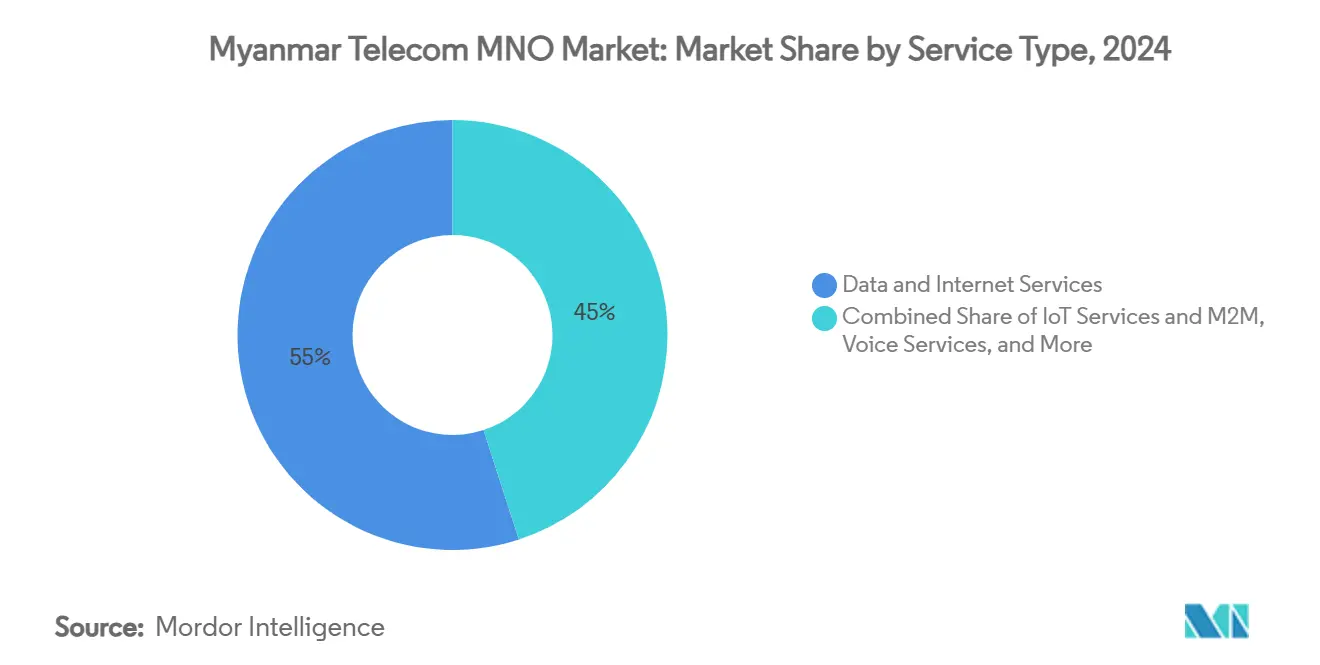
Note: Segment shares of all individual segments available upon report purchase
By End User: Consumer Segment Leads, Enterprise Accelerates
Consumers supplied 78.94% of 2024 revenue, driven by mobile data, voice, and fintech usage. The Myanmar telecom MNO market will still lean on mass-market demand, though rising inflation squeezes discretionary spend. Operators counter this with sachet-sized data packs and loyalty rewards integrated in super-apps.
Enterprises will scale faster at 2.77% CAGR as they digitize logistics, manufacturing, and payments. Case studies such as Huawei Cloud deployments demonstrate 15% cost savings, validating telecom-delivered ICT solutions. Managed security, IoT connectivity, and SLA-based fiber lines diversify operator portfolios and hedge consumer volatility.
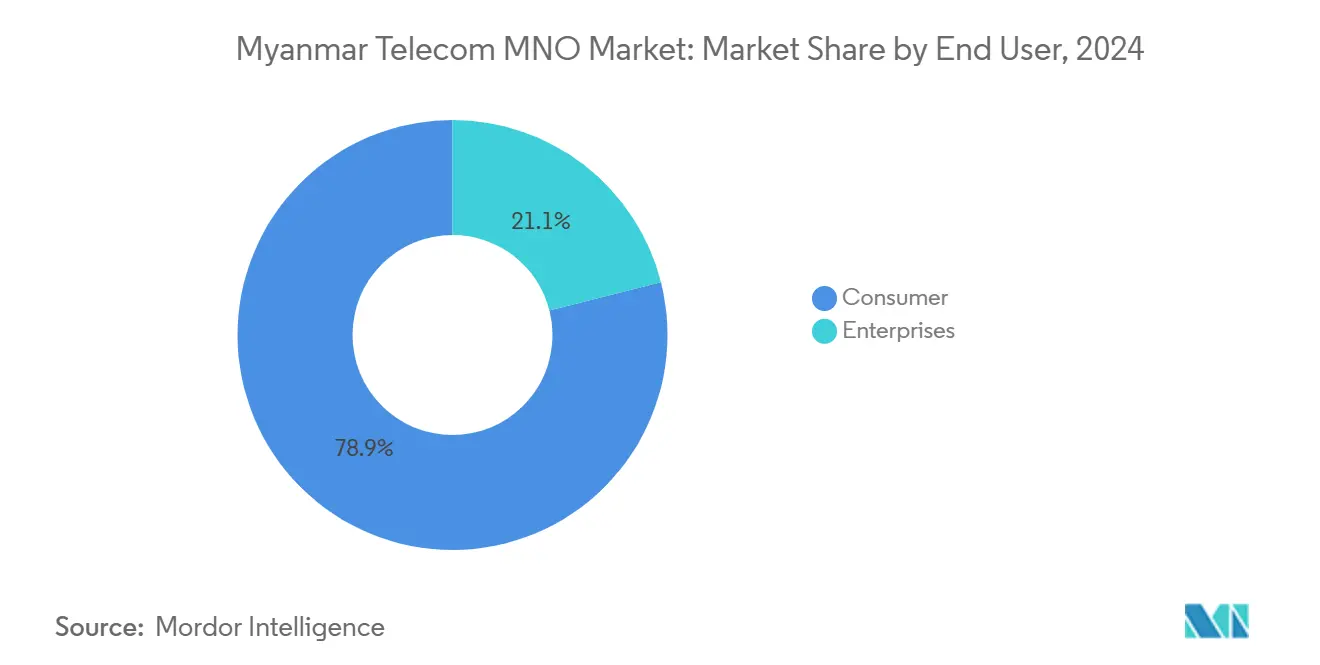
Geography Analysis
Urban centers Yangon and Mandalay capture disproportionate investment, enjoying dense 4G sites, FTTH corridors, and the country’s only pilot 5G cells. These cities form the commercial nucleus where the Myanmar telecom MNO market monetizes high-ARPU enterprise and consumer clusters. Rural township coverage relies on diesel-powered macro towers that face fuel cost inflation, yet they remain lifelines for mobile voice and money transfers.
Conflict-affected regions endure repeated shutdowns; 82 townships experienced 130 outages in 2024, disrupting schooling, healthcare, and commerce. Satellite terminals—many unlicensed Starlink units—fill critical gaps, reflecting latent demand for resilient connectivity channelnewsasia.com. Operators weigh partnerships with regional satellite providers to legitimize back-haul while meeting state surveillance mandates.
Border zones such as Myawaddy contend with cross-border crime and cyber-scam syndicates that exploit local networks, prompting regulators to strengthen know-your-customer (KYC) rules and SIM registration audits. However, these corridors also enable roaming income and remittance traffic. Infrastructure proposals featuring solar-powered base stations signal opportunities to reduce generator dependency and stabilize rural coverage quality.
Competitive Landscape
Myanmar now functions as a tight oligopoly featuring MPT, military-linked Mytel, ATOM Myanmar, and the downsized Ooredoo unit. The Myanmar telecom MNO market witnessed exits by Telenor and Axiata, concentrating share among domestic stakeholders. Political alignment influences spectrum access and license renewal, meaning competitive strategy hinges on regulatory goodwill as much as on network efficiency.
Operators differentiate through digital ecosystems. MPT has leveraged its FTTH footprint plus the MyID super-app to entwine communications with payments and streaming. ATOM focuses on customer-experience modernization through the ZTE BSS overhaul, promising faster product roll-outs and real-time charging. Mytel combines military logistics with civilian retail to push aggressive rural expansion, though US sanctions raise supplier-pipeline uncertainty.
Capital constraints shift emphasis toward cost optimization. Tower-sharing, renewable energy pilots, and vendor-financed radio equipment are common tactics. Enterprise IoT, satellite-terrestrial back-haul, and cybersecurity services emerge as white-space arenas where operators can mitigate slowing consumer growth and de-risk ARPU.
Myanmar Telecom MNO Industry Leaders
-
MPT Myanmar
-
ATOM Myanmar
-
Mytel
- *Disclaimer: Major Players sorted in no particular order
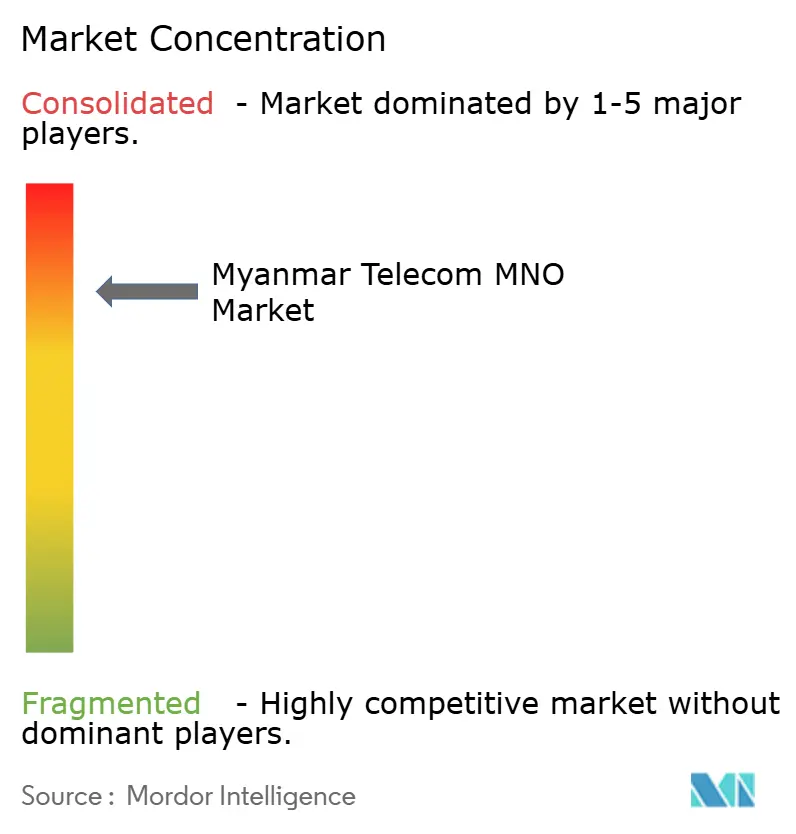
Recent Industry Developments
- January 2025: The US Treasury Department imposed sanctions on Mytel, marking the first international sanctions against a military-owned telecom operator in Myanmar, potentially disrupting revenue streams exceeding USD 700 million and forcing American tech firms to cut business ties with the company.
- January 2025: Myanmar’s military junta enacted a repressive cybersecurity bill enhancing state control over digital communications, with significant implications for telecom operators’ data handling and surveillance obligations.
- July 2024: Local telecommunications operators, including MPT and ATOM, announced 5G network availability plans for major cities such as Yangon, with testing beginning in Jun 2024, promising speeds up to 1 Gbps.
- January 2024: Ooredoo launched eSIM services in the Myanmar market, enhancing digital connectivity options and modernizing subscriber management capabilities.
Myanmar Telecom MNO Market Report Scope
The study provides an in-depth analysis of the Telecommunication industry in Myanmar.
The Myanmar telecom market is segmented by service (voice services (wired, wireless), data and messaging services, and OTT and pay TV). The market sizes and forecasts are provided in terms of value (USD million) for all the above segments.
| Voice Services |
| Data and Internet Services |
| Messaging Services |
| IoT and M2M Services |
| OTT and PayTV Services |
| Other Services (VAS, Roaming and International Services, Enterprise and Wholesale Services, etc.) |
| Enterprises |
| Consumer |
| Service Type | Voice Services |
| Data and Internet Services | |
| Messaging Services | |
| IoT and M2M Services | |
| OTT and PayTV Services | |
| Other Services (VAS, Roaming and International Services, Enterprise and Wholesale Services, etc.) | |
| End-User | Enterprises |
| Consumer |
Key Questions Answered in the Report
What is the current value of the Myanmar telecom market?
The market is worth USD 1.82 billion in 2025 and is projected to grow to USD 2.04 billion by 2030 at a 2.30% CAGR.
Which service segment holds the largest revenue share?
Data services lead with 55.01% of revenue in 2024, reflecting Myanmar’s rapid shift toward mobile and fixed broadband usage
How significant is enterprise demand in the Myanmar telecom industry?
Enterprise services are expanding at a 2.77% CAGR as businesses adopt cloud, IoT, and managed security solutions for resilience.
What impact do US sanctions have on local operators?
Sanctions limit access to foreign capital and equipment, especially for Mytel, forcing operators to rely on regional suppliers and slowing network upgrades.
Why are satellite partnerships important in Myanmar?
Satellite back-haul ensures connectivity in conflict zones and during internet shutdowns, offering critical redundancy where terrestrial networks are disrupted.
How is mobile money influencing ARPU?
Platforms such as Wave Money and KBZPay enlarge the transaction ecosystem, generating fee income and boosting data usage that lifts overall ARPU.
Page last updated on:
